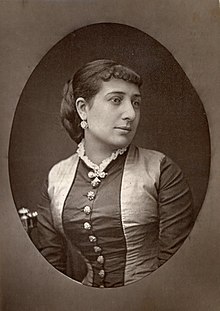Émilie Ambre
Émilie Ambre , actually Émilie Gabrielle Adèle Ambroise (born June 6, 1854 in Oran , † 1898 in Paris ) was a French opera singer (soprano).
Life
Émilie Gabrielle Adèle Ambroise was born in Oran, North Africa, as the daughter of the Frenchman Étienne Ambroise and his wife Olympe Romain. The mother died when the daughter was two years old. She received her training as a singer at the Conservatory of Music in Marseille and then performed as a soprano under the stage name Émilie Ambre.
She made her stage debut as a singer in the 1876-77 season at the Koninklijke Schouwburg Theater in The Hague . During her stay in the Netherlands she had a love affair with the Dutch King Wilhelm III. In her autobiography Émilie Ambre, une diva , published in 1885, she reported that the king made her generous gifts, wanted to give her the title of Countess Ambroise and made her a proposal of marriage. He was even prepared to relinquish the throne because of her if she had given up her stage career in return. How far the singer's statements are true is not known. There was no wedding and the king remained in office.
In 1878 she had her first appearance in Giuseppe Verdi's opera La traviata in the Paris Théâtre-Italien . In the same year she sang the opera Aida as the first interpreter in French . The performance took place under the direction of the composer Verdi. She received little praise from the critics and the author Beth Archer Brombert certified her with a mediocre talent ("middling talent"). Hoping for greater success, she toured the United States from 1879 to 1880. She appeared in the title role of the opera Carmen in New York, Boston and other cities . On this trip, she had the large-format painting The Execution of Emperor Maximilian of Mexico (now Kunsthalle Mannheim ) by Édouard Manet with her, which she helped bring to the exhibition. On her return, Manet painted a portrait of Émilie Ambre in the role of Carmen (now the Philadelphia Museum of Art ), although she was never seen in this role in France.
In 1880 she went on tour again to the United States. With the opera company of James Henry Maplesons she sang the title role in the opera Mignon by Ambroise Thomas , Marguerite in the opera Faust by Charles Gounod and appeared in the title role of Aida . They then performed at the French Opera House in New Orleans . On another tour to the United States in 1881, she took on appearances in Aida and Faust as well as the role of Violetta Valéry in Verdi's La Traviata .
After her return she lived temporarily in the Paris suburb of Bellevue . She married the organist Émile Bouichère and ran a singing school in Paris.
literature
- Émilie Ambre: Émilie Ambre, une diva (autobiography). P. Ollendorff, Paris 1885.
- Beth Archer Brombert: Edouard Manet, rebel in a frock coat . Little, Brown and Co., Boston 1996, ISBN 0-316-10947-9 .
- Sylvie Jouanny: L'actrice et ses doubles, figures et représentations de la femme de spectacle à la fin du XIXe siècle . Droz, Geneva 2002, ISBN 2-600-00601-X .
- Mary Anne Stevens: Manet, portraying life . Royal Academy of Arts, London 2012, ISBN 1-905711-74-3 .
Individual evidence
- ↑ The year of birth 1854 is found repeatedly in the literature (for example in Mary Anne Stevens: Manet, portraying life , p. 190) and is thus noted in the VIAF and the Library of Congress. In contrast to this, there is the indication 1849 on various websites.
- ↑ Beth Archer Brombert: Edouard Manet , p. 378.
- ↑ Beth Archer Brombert: Edouard Manet , p. 378.
- ↑ Rosenblatt Lehmbeck, Leah, 2007: Édouard Manet's portraits of women. A dissertation in partial fulfillment of the requeriment for the degree of Doctor of Philosophy Institute of Fine Art New York University. New York. 387p. [http://books.google.co.ve/books?id=pwtR_LDdJ0gC&pg=PA251&lpg=PA251&dq=Suzette+Lemaire&source=bl&ots=1gsdIhg64_&sig=fRkZkxuPk0xkxBpXaWGJYj6tKVE ]&
| personal data | |
|---|---|
| SURNAME | Ambre, Émilie |
| ALTERNATIVE NAMES | Ambroise, Émilie Gabrielle Adèle (real name) |
| BRIEF DESCRIPTION | French opera singer (soprano) |
| DATE OF BIRTH | June 6, 1854 |
| PLACE OF BIRTH | Oran |
| DATE OF DEATH | 1898 |
| Place of death | Paris |

